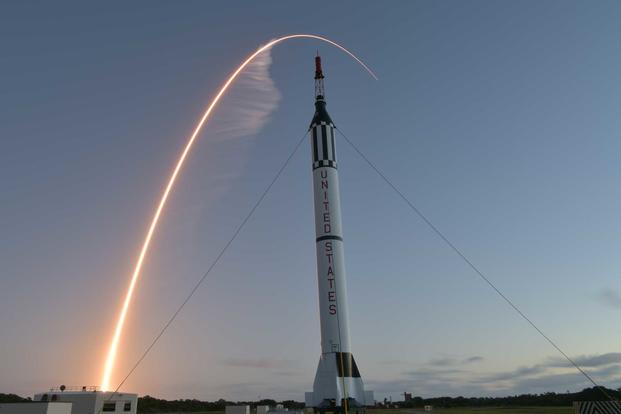Lawmakers will not allow the U.S. Space Force to realign Air Force bases that host space missions under its wing until they get a full analysis of those potential moves.
In the Senate Armed Services Committee's version of the fiscal 2021 National Defense Authorization legislation, lawmakers have paused the transfer of "military installations to Space Force prior to analysis by the Secretary of the Air Force being presented to the congressional defense committees," according to the bill's executive summary language.
Read Next: Navy Carrier Ford's High-Tech EMALS Catapult System Breaks During Sea Trials
The move could slow the Space Force's plan to rename bases that would become the foundation of its structure.
The sixth military service -- signed into existence under the 2020 National Defense Authorization Act by President Donald Trump on Dec. 20, 2019 -- is currently operating with the aid of 16,000 airmen detailed temporarily from what was formerly known as Air Force Space Command.
At the time of the signing, Gen. John "Jay" Raymond, the chief of space operations for the Space Force, said plans were underway to redesignate Air Force units and realign bases for the space mission.
For example, "Patrick Air Force Base" might be renamed "Patrick Space Base" or something to that effect, the general said during a briefing at the Pentagon.
In April, the Air Force identified 23 organizations and units with space-specific missions that will transition to the Space Force over the next six months. But the COVID-19 pandemic response has delayed the renaming of bases.
Naming ceremonies will be scheduled when they can be conducted "in an appropriate manner, [while] keeping everyone attending these ceremonies safe," Raymond said in March.
Space Reserve vs. Guard
The Senate committee's bill summary also allows the Space Force to establish a reserve component, but "delays establishment of a Space National Guard until the completion of a study on the issue," officials said.
While Guardsmen and reservists who are already executing space missions and currently aligned with the new branch will continue supporting it, officials are weighing how best to incorporate them into the larger Space Force enterprise.
In February, adjutants general from California, Alaska, Hawaii, Florida and Colorado said they were concerned they didn't have clear direction from the Defense Department on their chain of command structure with the Space Force in the mix.
The leaders' worries were prompted by a report sent to Congress on Feb. 3.
"When that report went across to Congress, I got called by my units going, 'What does this mean for me?'" said Maj. Gen. Michael Loh, the adjutant general for Colorado. Loh has since been nominated to pin on his third star and become the Air National Guard director, replacing Gen. L. Scott Rice.
Loh said Guardsmen create a "force multiplier" of expertise, not only because of their military service but also because many use relevant skills in their day jobs.
But a new study suggests the undertaking may not be as seamless, nor as economical, as the Guard may think.
According to the nonpartisan Congressional Budget Office, it could require as much as "$100 million in additional costs annually to operate and support this smaller Space National Guard" of about 1,500 people.
Currently, roughly 1,500 Air Force and Army Guardsmen serve in space-focused jobs across nine states.
Should the Space Guard grow to anywhere between 4,900 to 5,800 personnel, the Defense Department would incur costs between $385 million and $490 million per year, the report said.
Speaking during a Mitchell Institute event Wednesday, Rice said the Air National Guard and the Air Force are still studying the issue and intend to present the report's findings to Defense Secretary Mark Esper "soon."
Rice did not write off a Guard element entirely.
"We're working with [Raymond] and the Secretary of the Air Force [Barbara Barrett] to present these ideas of a single service with an active and reserve under [Raymond], and an additional reserve component from the National Guard," he said.
-- Oriana Pawlyk can be reached at oriana.pawlyk@military.com. Follow her on Twitter at @Oriana0214.
Related: More Than 8,500 Airmen Have Volunteered to Join Space Force












